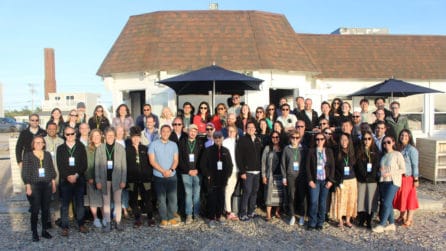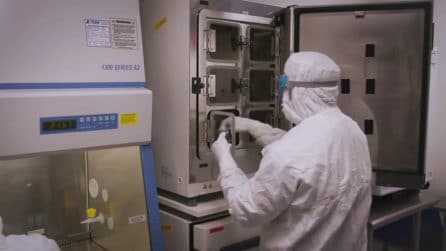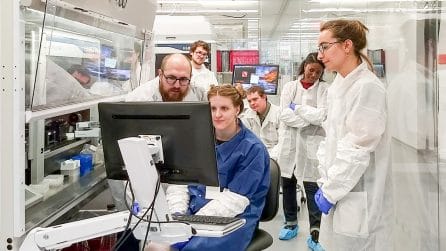Scientist, Entrepreneur, and Hockey Dad: Meet NYSCF Interim CEO Derrick Rossi
NewsEven if you don’t know Derrick Rossi, PhD, you almost certainly know Moderna: the company behind mRNA vaccine technology he co-founded that is protecting millions from COVID-19.
And if you do know him, you might not be aware that he was a member of the NYSCF – Robertson Stem Cell Investigator Program’s inaugural class. He has been a longtime advisor, friend, and Board member of NYSCF, and has now stepped into the role of NYSCF Interim CEO.
Hear from Dr. Rossi about his relationship with NYSCF, why he’s excited about the future of stem cell research, and how he envisions this work reaching patients.
How did you first hear about NYSCF?
My first introduction to NYSCF was in 2010 when I was three years into my faculty position at Harvard Medical School, and constantly thinking about how to fund my research. I found out about the NYSCF – Robertson Investigator Program and was part of the first class to receive the award.
How did this award impact your career?
When I got the grant, I thought of it primarily as a funding source – and it was a very good funding source. It provided unrestricted funding to put toward whatever we thought to be the most promising science. But I think what ended up being more important was the community aspect of the award.
The awardees would meet each year for a retreat to share our work, and being a part of the first class, I watched as this group grew from five to ten, fifteen, twenty of us. And it was such a tight knit community where you were exposed to so much science from experts in fields that you may not be well versed in.
Just to give an example of its impact, I was at the retreat one year and I was particularly struck by a presentation from Case Western University’s Paul Tesar on his work in multiple sclerosis. I saw that there could be a real path forward to take his results and move it into biotech and into patients. So at the coffee break, I asked him “who are you talking to?” and he assumed I meant which journal was he considering sending his study to for publication. But what I really meant was – which VCs are you talking to raise funds to launch a company to bring these important findings to patients? I had some experience raising money to launch biotechs so I started to advise Paul on that, and that evolved into a company called Convelo Therapeutics that works on remyelinating therapies for people suffering from diseases such as multiple sclerosis.
So all of that is to say that while the funding was extremely impactful and fueled much of the science we did in my lab for five years, the NYSCF community of outstanding scientists was just as impactful.
How have you seen the NYSCF – Robertson Investigator Program impact the field as a whole?
The impact has been substantial. Every academic scientist has multiple jobs: we’re trained for the science part, but we’re not necessarily trained for the money raising part. Scientists are always thinking about when our funding is going to end, what we need, or great ideas that can’t seem to get funded.

Talk to any of the NYSCF – Robertson Investigators and they’ll say that this award is just raw fuel for science. It’s like throwing a rock in a pond: you get these ripples that just go on and on – and normally they would diminish, but if you have something seismic that happens underneath the pond and adds just a bit of fuel, then all the sudden you can get a wave. That’s what this award does – it helps lift the whole field up.
Why are you excited about the future of NYSCF’s research?

I had been informally advising Susan [Solomon, NYSCF Founding CEO] for years on how to take NYSCF’s research from the lab to the clinic. Susan was always optimistic about this, and I think NYSCF is now at a place where there’s enough meat on the bones of these programs that we can start taking them to clinical development. We’re seeing it now with the age-related macular degeneration (AMD) program [that is moving towards a clinical trial].
NYSCF’s work has the potential to impact a lot of patients – and I want to help in whatever way I can since I have experience bringing treatments to patients. I’ve seen that movie before, and I think that with NYSCF’s philanthropic roots, we’re getting there.
What makes NYSCF a unique organization in the stem cell field?
NYSCF is unique because it has both substantial internal research programs as well as external funding of investigators around the world. Typically you’re either a funder, a research institute, or a biotech. It’s remarkable that NYSCF can be all these things at once, and that’s a real testament to the staff. It’s also important to recognize that all this is driven by philanthropic dollars.
This allows us to be sort of ‘stem cell therapy agnostic,’ meaning we’re not limited to just one area of stem cell science – we’ll follow whatever is most promising. That’s very unique. We have the ability to see a great idea and say ‘hey, let’s support that,’ even if it’s something we’re not already working on.
Why are stem cells so important for disease research and treatment?
I could give a 40-day answer to that question, but I’ll focus on just the research aspect. With induced pluripotent stem cells, we have the ability to make any cell type in the body, and that means we can model diseases in the lab. This has gotten incredibly sophisticated, and NYSCF is leading the way here. We are applying machine learning and artificial intelligence to look at patient-derived stem cells, and really gleaning tractable pathways and paradigms to better understand disease.

Then, there’s NYSCF’s commitment to diversity in stem cell research. The way biomedical science used to be conducted was using cells from white males. So what NYSCF has done is collect samples and make stem cells from large groups of patients that includes women and underrepresented minorities and people of different ages to really understand how diseases impact the population at large.
And here’s the thing about biology: the more patients we’re looking at, the more statistically relevant and actionable the ensuing results will be. Preclinical studies are typically done on one or two patient cell lines, and when you go into the clinic, lo and behold, it fails, because you’ve come up with something that isn’t relevant to a large population of patients. With stem cells, and especially with NYSCF’s unique technologies for creating them, we can do these preclinical studies on cells from many different people.
One of your major discoveries was this ability to reprogram stem cells using mRNA. And can you tell us a little bit about how this led to the co-founding of Moderna?
While our original work was focused on using mRNA to reprogram differentiated cells back to a pluripotent state in experiments conducted in dishes outside of the human body, once we had mastered the technology, I turned my attention and focus to the idea that the mRNA technology could be used directly to treat disease in patients. As a molecular biologist I knew that DNA makes mRNA, and mRNA, in turn, makes proteins, and proteins ultimately orchestrating all aspects of life. In genetic diseases however, DNA bearing mutations gives rise to mutated mRNA, and that mutated mRNA makes non-functional or dysfunctional proteins which give rise to disease. Incredibly, there are more than 6,000 human diseases whose pathologies are underwritten through this basic paradigm: mutated DNA, makes mutated mRNA, makes dysfunctional protein yielding disease.
So, when I first founded Moderna in 2010, my vision was to tackle this disease paradigm directly in patients using synthetic mRNA. And now jumping ahead to present day 2022, we see that mRNA therapeutics has indeed become a major therapeutic paradigm with hundreds of ongoing clinical trials using the core mRNA technology, and of course, the mRNA vaccines having been used extremely effectively in hundreds of millions of people to protect against COVID-19.
Outside of all these roles in science and business, what do you enjoy doing for fun?
I’m really interested in cinema and have been involved in relaunching Castle Rock Entertainment in partnership with Rob Reiner and others. I’ve spent a lot of time over the past couple of years learning about the film industry and how films are made which has been a lot of fun.
I also love spending time with my children and my dog. I have three daughters and I’m a proud hockey dad, so I am frequently at hockey rinks, which I love.

